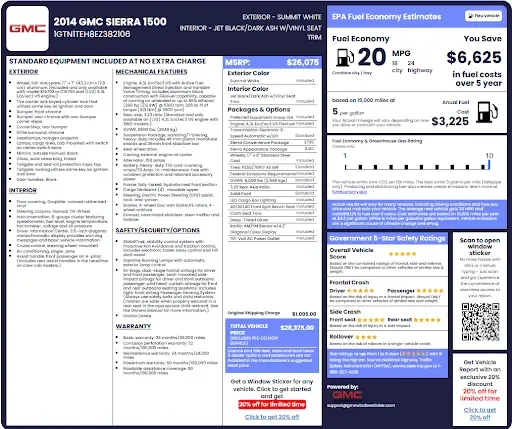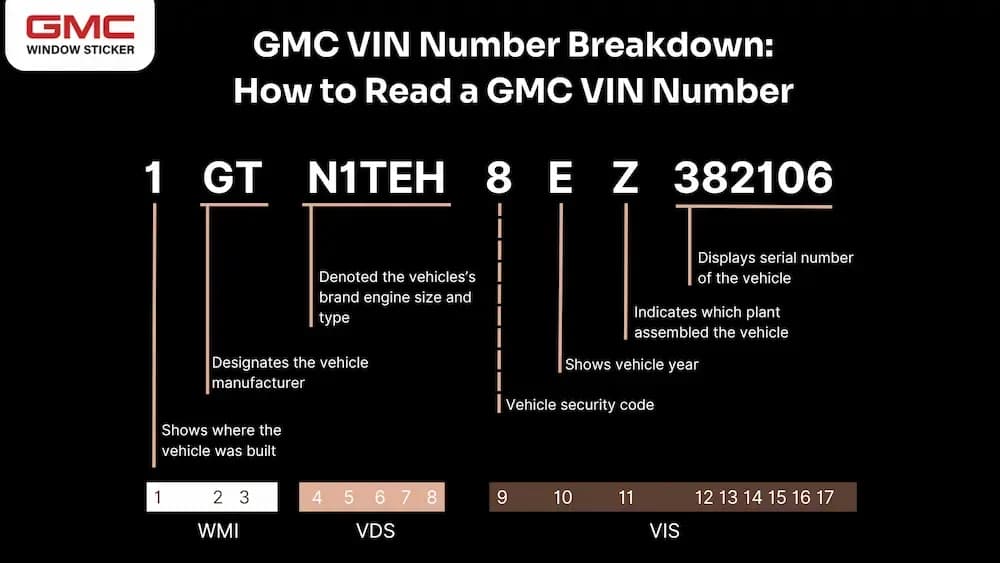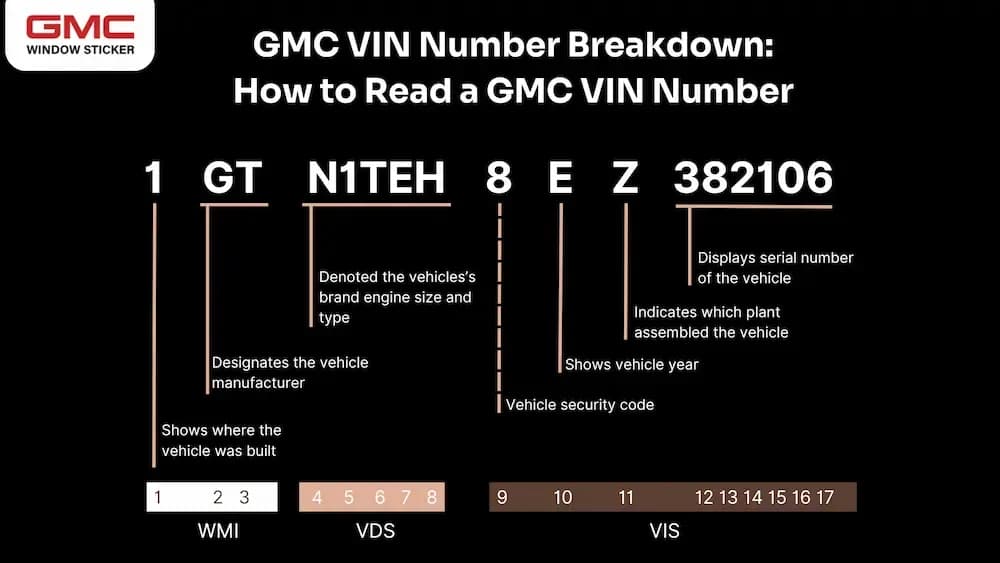GMC Window Sticker by VIN
See your GMC’s full factory build in seconds. Enter your VIN to get a 100% accurate window sticker PDF. This window sticker includes the MSRP, options, packages, and EPA ratings. So you can buy with total confidence today.
What is a GMC Window Sticker?
A window sticker (often called a Monroney label) is the official sheet that lists how your GMC left the factory, including information like base MSRP, destination, standard equipment, factory options/packages, plus EPA fuel economy and often safety info. It’s tied to your exact VIN, so what you see is your truck/SUV’s true build, not “probably” or “I think.”
With a GMC window sticker, buyers can confirm the real build, price, and engine in seconds. Sellers can show proof of value, so talks stay calm and fair.
Why You Need a GMC Window Sticker Lookup?
If you are interested in GMC, getting a window sticker is important whether you’re the seller, buyer, or a GMC dealer. Here are the reasons why:
For GMC Buyers
1. Confirms the exact trim, drivetrain, and factory options tied to the VIN, preventing mix-ups caused by photos, badges, or incomplete listings.2. Shows original MSRP with line-by-line option pricing, giving a clear starting point for comparing vehicles and negotiating with confidence.3. Displays EPA fuel-economy figures and estimated costs, helping budget daily running expenses before arranging a test drive or financing.4. Presents NHTSA safety ratings in a standard format, making side-by-side comparisons simple across model years and trims.5. Lists factory packages by name, showing meaningful differences between similar trucks or SUVs that may look identical in photos.
For GMC Sellers
1. Builds trust immediately by showing the official factory configuration, reducing skepticism and back-and-forth explanations about options.2. Justifies the asking price with base MSRP, option prices, and destination charge presented in an organized, recognized format that buyers respect.3. Enables accurate listings that avoid trim or package mistakes, cutting down on price disputes and renegotiations after inspections.4. Highlights rare or high-value options that deserve mention in ads, helping differentiate the vehicle from lower-spec competitors.5. Reduces time on market because serious shoppers self-qualify after reading the label, improving lead quality and appointment show rates.
For GMC Dealer
1. Improves appraisal accuracy on trades by confirming equipment instantly, preventing over-allowances based on assumed features.2. Assists service and parts departments with accurate engine, transmission, and package identifiers, improving first-time-right orders.3. Reduces after-sales disputes by documenting what the vehicle included at delivery, helpful for We-Owe items and accessory discussions.4. Speeds reconditioning planning by revealing equipment that affects cost, such as advanced driver-assist hardware or premium interiors.5. Enables fast cross-store or auction transfers since the receiving team can verify configuration immediately without chasing build sheets.
What Information Does a GMC Window Sticker Contain?

The GMC window sticker details your vehicle’s features and specifications. Here’s what you can find from a GMC window sticker:
- Vehicle & VIN identifiers: The basics at the top: year, make (GMC), model/trim (e.g., Sierra 1500 Denali), drivetrain, body style, and the 17-character VIN. Often, you’ll also see exterior/interior color names and codes.
- MSRP, options, and total price: Shows how the vehicle’s price was built up at the factory. Check the base price, the original shipping charges, and optional features. Making it clear about what was added and what it cost.
- Factory options/packages: Factory options/packages are the extras installed by GMC before the truck leaves the plant (e.g., AT4X package, tech or trailering packages). Reading this line-by-line shows exactly what equipment raised the price and which features came from the factory rather than a dealer add-on. It’s the cleanest way to compare two similar VINs and to justify value in a listing or appraisal.
- Standard equipment (by trim): A rundown of features included without extra cost for that trim: safety tech, infotainment, seating, wheels/tires, lighting, towing basics, etc. Helps you compare trims quickly. For example, SLT vs. Denali will differ in standard audio, seats, and driver-assist tech.
- Powertrain details: Engine type and displacement (e.g., 5.3L V8, 3.0L Duramax diesel), transmission, and sometimes axle ratios or 4×4 systems. It matters because it affects towing, fuel economy, and long-term running costs. If you’re shopping Sierras, the engine line makes a big difference.
- EPA fuel economy & emissions (gas/diesel/EV): Lets you budget fuel or charging and compare models apples-to-apples.
- Safety ratings: Showing you the NHTSA star ratings, including the Overall Vehicle Score, Frontal and Side crash, and also the rollover score. One quick glance at safety performance. Helpful for family SUVs like the Yukon or Acadia.
- Options & packages: The meaty list of add-ons: premium audio, sunroof, off-road suspension, max trailering, driver-assist bundles, wheels, bed utility, etc.
- Exterior & interior colors with codes: Paint names (e.g., Titanium Rush, Summit White) and interior trims (Jet Black, Atmosphere/Brownstone) plus their codes. Useful for resale accuracy and parts ordering. Detailers, body shops, and buyers care about these codes.
- Warranty statements (as new): Basic bullet points about new-vehicle warranties (bumper-to-bumper, powertrain, corrosion) and sometimes roadside assistance when the vehicle was sold new.
- Parts content & assembly info: Where major components come from, U.S./Canadian parts content, and the final assembly plant.
- Tires, payload, and towing notes: Factory-equipped tire size/type and occasionally key trailering equipment lines. (Full payload/tow capacities are usually in the owner’s manual or towing guide; door-jamb labels show loading specifics.).
How To Read a GMC VIN?
Every GMC has a single 17-digit VIN (established in 1981).
GMC follows the standard structure, which is:
- WMI (1–3): who built it and where.
- VDS (4–8): what it is—body style, series, and engine.
- VIS (10–17): when and where it was assembled, plus its unique number.

Let’s break down what each of the GMC 17-digit VIN characters means:
1st Character
The first character shows where the vehicle was made, not the brand. For most GMC trucks and SUVs, you’ll see:
Other handy ones (for general VIN reading):
| 1, 4, or 5 | 2 | 3 | J | K | L | S | W |
|---|---|---|---|---|---|---|---|
| USA | Canada | Mexico | Japan | South Korea | China | United Kingdom | Germany |
Examples you might spot:
2nd Character
The 2nd character points to the manufacturer. When you pair it with the 1st character (country/region), you start to get the maker’s identity. Characters 1–3 together form the WMI (World Manufacturer Identifier).
For GMC specifically, you’ll almost always see “G” as the 2nd character.
So for most GMCs, if the 2nd character is G, you’re looking at a GM-built vehicle. The 3rd character then narrows it to the division (for GMC, often T for “GMC Truck”).
Why it matters:
3rd Character
The 3rd character helps identify the division and vehicle type/line within the manufacturer. Put together with the 1st (country) and 2nd (manufacturer), you get the WMI.
For GMC (common patterns), you’ll often see these combos:
1GT / 2GT / 3GT
1GK / 2GK / 3GK
The letter meanings above are how GM commonly uses them. Always read the full WMI, because exact assignments can vary by year/plant.
Why the 3rd character matters:
4th Characters
The 4th character is the first spot in the Vehicle Descriptor Section (VDS) (positions 4–9). From here onward, the VIN starts describing what the vehicle is: series, body type, restraint system, weight class, engine family, etc.
Under federal rules, the exact meaning of the 4th character can vary by brand, model, year, and plant, but for GMC, it typically helps point to things like series/body style or weight/usage class. Especially on trucks and vans. For GMC, what it usually points to is the first “zoom-in” on configuration:
Why this character matters:
5th Characters
The 5th character continues that story. It usually helps pin down things like:
It won’t be the same for every model year, so always read it with the other VDS characters.
Why you should care:
6th Characters
The 6th character keeps adding detail to what you already learned from the 4th and 5th. Depending on the model and year, it can point to things like:
Note: GM’s exact code meanings can change by model year and line. Always read the 6th together with 4th, 5th, 7th, 8th.
7th Characters
The 7th character is one of the quickest ways (with 4–6) to verify that a vehicle matches the claimed cab style, drive, or seating/wheelbase before you get lost in photos or ads.
8th Characters
On GMCs, the 8th is typically the engine identifier. It maps to the engine family/RPO (e.g., 2.7T, 5.3L V8, 6.2L V8, 3.0L Duramax diesel, or an EV motor family on HUMMER EV).
Why it matters: Engine choice affects towing, fuel economy, maintenance cost, and price. Two Sierras can look identical but have very different values if the 8th digit points to different engines.
Note: The 8th character is a single code. It doesn’t spell the full RPO (like L84, LZ0, etc.). You match that single code to a year-correct decoding table or confirm via the window sticker / RPO (service parts) label.
9th Character
Digit 9 is a computed check digit; it must match the federal formula. If it fails, the VIN is wrong. Keep a one-line explainer and a “why it matters” box.
10th Character
This digit tells you the model year of the GMC. Each letter or number maps to a specific year. For example, “T” can mean 2026 (check the correct chart for your VIN). Use a VIN year table to match it. Below are the common codes for recent years.
| A=2010 | B=2011 | C=2012 | D=2013 | E=2014 |
|---|---|---|---|---|
| F=2015 | G=2016 | H=2017 | J=2018 | K=2019 |
| L=2020 | M=2021 | N=2022 | P=2023 | R=2024 |
| S=2025 | T=2026 | V=2027 | W=2028 | X=2029 |
Key things to remember:
11th Character
Identifies the factory that built the vehicle (assembly plant). Plant data appears in manufacturer submissions and shows up in NHTSA’s public decoder results along with the country (1st character).
Why it matters:
12th to 17th Characters
Digits 12–17 are your GMC’s unique serial number. They don’t tell you the trim or engine. They simply identify the exact vehicle that left the line, whether it’s a Sierra, Yukon, Acadia, Terrain, Canyon, Savana, or HUMMER EV.
Why does it matter? It’s used for campaign cutoffs (like “vehicles built up to sequence 128000”) and parts catalogs that change mid-year. It also helps collectors and enthusiasts track early vs. late production of special trims (think Denali Ultimate, AT4X, etc.).
How Do I Get the GMC Window Sticker by VIN?
Here’s the easiest way to verify what your GMC left the factory with. Gather the VIN (or plate/year-make-model) and work through the steps below:
Step 1: Enter the VIN
Type your VIN. The VIN is a 17-character code (sometimes shorter in classic vehicles) that is found on every vehicle. No VIN? Our lookup can generate with a license plate, even with the year, make, and models of your GMC.
Step 2: Click “Get Window Sticker”
The system matches the VIN to factory build data and shows a quick preview to confirm the correct vehicle before payment.
Step 3: Pay and View Window Sticker
Complete checkout to download or print a clean PDF showing MSRP, options, colors, EPA fuel-economy box, and safety sections. Ready for listings, appraisals, or records.
With these steps, you will get full access to a copy of the window sticker for any GMC vehicle in just a few seconds. You can also try other alternatives like:
- GMC dealerships: Many can reprint a sticker from factory systems, but timing varies, and retail customers are prioritized.
- GMC’s customer site: Possible through support, yet responses aren’t instant and usually require follow-up.
- Owner forums: Great for learning and examples, but rarely an exact VIN match; always confirm with an official lookup.
Where Can You Find a VIN on a GMC Vehicle?
A VIN is a 17-character code that identifies your GMC (some classic models may have shorter numbers).
You can spot it in a few easy places:
- Windshield corner (driver side): Look through the glass at the base of the windshield.
- Driver-door jamb: On the certification label or door frame sticker.
- Documents: Registration, insurance card, service records.
- Engine bay/frame labels: On some trucks/SUVs, stamped or on a plate.
- Infotainment → Settings → About/Vehicle Info (many late-model GMCs show the VIN).
- OnStar / GMC mobile app (if the vehicle is linked to your account).

Why Choose Us to Get Your GMC Window Sticker?
Below are some extra-detailed reasons why you should choose us for your GMC Window Sticker:
100% Accurate GMC Data
We use VIN-specific build details. That means the sticker matches your GMC, not a “similar” model. MSRP, factory options, colors, EPA ratings, and more, all tied to the exact 17 characters you enter. Fewer doubts. Better decisions.
Fast Results in Seconds
Type the VIN, hit Search, and wait a moment. That’s it. You get a quick preview, then an instant PDF after checkout. It works well on mobile too, so you can use it at the lot or during a test drive.
Covers All GMC Models
From Sierra 1500 and HD, Canyon, Yukon and Yukon XL, Acadia, Terrain, Savana, and even HUMMER EV. All of the GMC old and new vehicles.
Looking at two different years? Different plants? That’s fine. One tool handles them all. Many tools only work well for a few years or a few models. Ours is built for the full GMC range.
Useful for Buyers and Sellers
Buyers: See the truth before you pay. The real options, real engine, real packages. Easier to compare two similar trucks.
Sellers: Post the sticker with your listing. It builds trust and saves time. Fewer “Does it have…?” messages.
Some platforms hide details behind paywalls. We put the key info front and center.
Easy Checkout Process
Getting the sticker is simple: find your VIN, submit the form, and then download. If you don’t have a VIN, use your license plate. Instant access. Save it, print it, or attach it to your listing in seconds.
Clear Layout
Readable sections, logical flow, high-contrast fonts. You’ll see MSRP, options, colors, EPA info, and safety notes are grouped in a tidy way. Other tools cram text into one block. We keep sections separate so you can scan fast.
Get Window Stickers for Popular GMC Models
Shopping around for a GMC? Get the window stickers for these best-selling models. Our GMC window sticker lookup works for every model.
| GMC Sierra | GMC Canyon | GMC Hummer EV |
| GMC Yukon | GMC Terrain | GMC Envoy |
| GMC Acadia | GMC Savana | GMC Safari |
← Scroll horizontally to see more →
Get More Than GMC Window Stickers With These Tools
After you see the factory build, dig deeper. Check the paint code, warranty specs, and more of the GMC. So you can make a confident decision.
GMC VIN Decoder
Decode to confirm the country of build, manufacturer, model family, body style, engine, and model year of the GMC. It’s the fast sanity check before pricing comparisons, trade appraisals, or history research.
GMC Warranty Check by VIN
See core warranty details and in-service timing where available. Estimate remaining coverage, plan extended protection, and avoid surprises at the service desk.
GMC Specs by VIN
Get VIN-true specifications (powertrain details, key dimensions, and capacities). So you can compare trims accurately and match a vehicle to real-world needs.
GMC Paint Codes
Confirm the original exterior paint and interior trim codes for precise touch-ups, panel work, or restorations. Keep authenticity and resale appeal intact.
GMC Transmission Lookup
Pull the factory transmission model/code tied to the VIN—gear count, type, and OEM identifiers. Perfect for parts ordering, correct fluid/service planning, and understanding tow/payload implications on trucks and SUVs.
GMC Buildsheet by VIN
Request deeper production data (including GM RPO codes) for accurate parts sourcing and documentation, especially helpful on special edition trucks, commercial builds, and classics.
Decode Your GMC Window Sticker Now
Enter your VIN (or plate) to see how your GMC left the factory. Unveil the original MSRP, option packages, paint and interior codes, engine and transmission details, and more.
FAQ about GMC Window Stickers
It shows the exact factory build for that vehicle, things like AWD/4×4, premium audio, driver-assist packages, wheel option, and the paint/interior codes. This helps you compare like-for-like, catch any mismatched claims, and negotiate with confidence.
